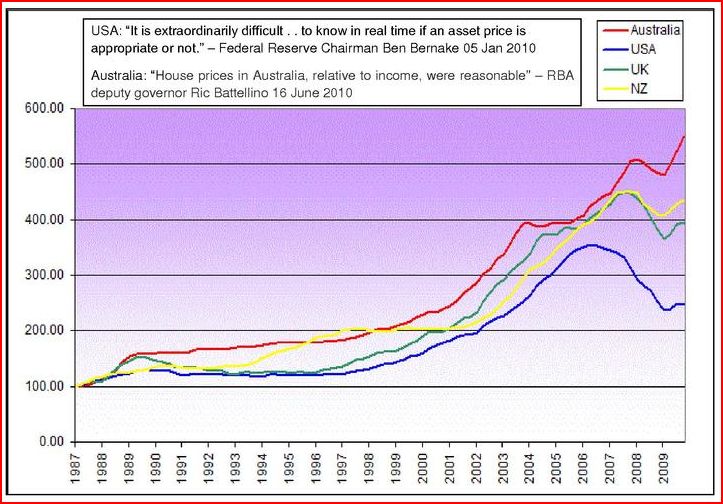Rich, egalitarian, low-tax Australia
From The Economist:
TWENTY YEARS OF reform in Australia did not roll off without resistance, so sweeteners were needed to buy off opposition. One of the most inspired was superannuation, a long word meaning private pension provision that the all-abbreviating Aussies call their “super”. Used in the 1970s and 1980s to please trade unionists (and helping to keep a lid on inflation), it has turned into the financial equivalent of the Swiss army knife, with a multiplicity of benefits.
In 1992 the Keating government made it mandatory for employers to pay a proportion of the wages of all but the very lowest-paid workers into a superannuation account. The payment, which was tax-deductible, was to rise in annual steps to 9%, where it is today, though by 2019 it should be 12%. Employees choose the funds that receive their payments.
The upshot is that most Australian workers, over 8m in total, now have a private nest-egg for their old age. No tax is paid when members withdraw from their fund; they can take all they want as a lump sum, subject to a limit, or buy an annuity. Aussies are now a nation of capitalists.
At the same time the state pension system, and therefore the taxpayer, is being progressively relieved of most of the burden of retirement provision, since eligibility for the state pension depends on both assets and income. As supers take over, the provision for old folks’ incomes will be almost entirely based on defined contributions, not defined benefits. So Australia is in the happy position of not having to worry too much about the pension implications of an ageing population, though it may have a problem for six or seven years after 2014 when the post-war baby-boomers stop work with supers only half filled.
The entitlement problems facing the West are not difficult to solve (in a technical sense.) They’re easy to solve. You just have to get on with doing it. My commenters always dismiss the Singapore model because their society is so different from ours. But there are few countries in the world more similar to America than Australia (I’ve lived there.)
And here’s the impact on equality:
Mr Howard claims Australia has a unique form of egalitarianism, and David Alexander, who used to work for Mr Howard’s treasurer, recently argued in Policy magazine that Australia has developed a model of small-government egalitarianism that uniquely combines economic liberalism and egalitarian policy structures. Citing figures from the Organisation for Economic Co-operation and Development’s 2010 Survey, he points out that, among rich countries, Australia had the lowest government spending and the lowest taxes. At the same time it ranked below average for income inequality and close to bottom for inequality of wealth, using the standard (Gini coefficient) measures.
Two factors, he says, contribute to these “fair dos” positions. One is Australia’s system for making welfare and other transfers to the less well off, which is the most progressive in the world. The second is its tax system, one of the most progressive in the OECD. The upshot is what Mr Alexander calls a platypus model. Just like its egg-laying mammal, Australia defies the categorisers by being neither small-government and inequality-tolerant, as America is, nor high-taxing and egalitarian, as the Scandinavians are. This exceptionalism, believes Mr Alexander, makes Australia a happy and harmonious society in which populism is less likely and the chances for difficult reforms and real competition are better. (Italics added)
But does all this egalitarianism hurt growth?
Only a dozen economies are bigger, and only six nations are richer””of which Switzerland alone has even a third as many people. Australia is rich, tranquil and mostly overlooked, yet it has a story to tell. Its current prosperity was far from inevitable. Twenty-five years ago Paul Keating, the country’s treasurer (finance minister), declared that if Australia failed to reform it would become a banana republic. Barely five years later, after a nasty recession, the country began a period of uninterrupted economic expansion matched by no other rich country. It continues to this day. This special report will explain how this has come about and ask whether it can last.
Those with a passing acquaintance of Australia will attribute its success to its luck in having such an abundance of minerals that its booming Asian neighbours want to buy. That is certainly part of the story. Yet Australia was not dragged down when a financial crisis struck Asia in 1997. And commodity exports have not always been fashionable. In the 1990s many thought they were evidence of an incorrigibly “old”, low-tech economy doomed to decline. Australia’s terms of trade””the ratio of its export prices to its import prices””seemed stuck at unfavourably low levels. Not until 2003 did minerals begin to boom again, though by then Australia had escaped both the Asian crisis and the recession that hit America in 2001. Five years later came the GFC, Oz-speak for global financial crisis. Yet that, too, failed to drive Australia into recession. Someone, other than Lady Luck, must have been doing something right.
Note to progressives: Stop talking about France! If the rich liberal states in the Northeast can’t even build high-speed rail in the Bos-Wash corridor, how the hell are we going to roll out the French model nationwide? And will Americans pay 50% of GDP in taxes? Australia’s the right model for progressives. Americans will support egalitarian measures that don’t hurt growth, and don’t require high taxes.


